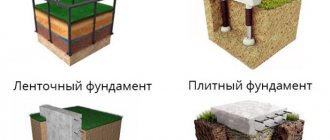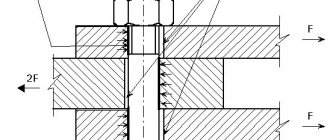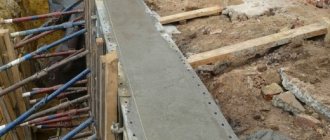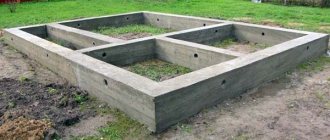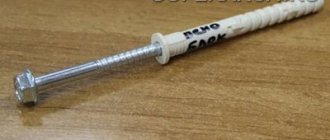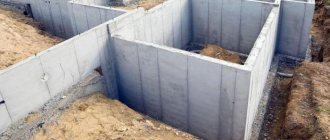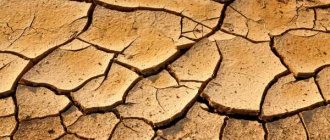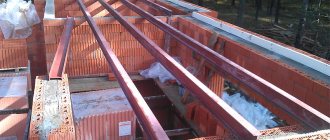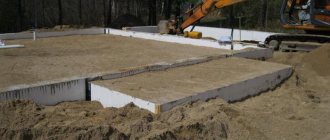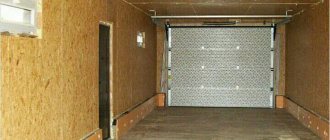The soil under the power structure must be strengthened, and special measures must be taken to protect the foundation of the house from moisture and exposure to chemicals. These and other functions are performed by a layer of geotextiles.
What is special about the technique and what geotextiles are needed for the foundation slab will be discussed in the material.
Purpose of geosynthetic material during foundation construction
Waterproofing of building structures is one of the important elements of protecting buildings and structures from environmental influences. Waterproofing of all types of foundations deserves special attention in this matter, because contact of moisture with reinforced concrete or metal certainly leads to a decrease in the performance characteristics of foundations.
Geotextile is a thermally treated fabric made of polyester fibers that has all the necessary functions to protect the base from water and chemical reactions.
Advantageous characteristics of the material:
is durable (up to 50 years);- does not absorb soil moisture;
- resistant to temperature changes in the range from –60 to +100 °C;
- not susceptible to the formation of fungus and mold;
- prevents plant roots from germinating;
- protects the foundation from rodents;
- environmentally friendly raw materials.
Geotextiles are effective in the construction of slab foundations on various soils:
- Sandy ones, which, despite their high load-bearing capacity and low degree of heaving, are permeable to groundwater.
- Clay ones are too mobile to guarantee the durability of the structure, so they need reinforcement.
- Peat - they represent too weak a foundation and in this case the builder needs to recreate a stable support.
Functions of the canvas
The purpose of geotextiles for slab foundations is as follows:
- Reinforcement – makes the base of the structure elastic and at the same time is responsible for the distribution of loads. Reinforcing geotextiles several times increase the bearing capacity of the soil under the base of the foundation. If you plan to build a complex structure on a slab with uneven pressure on the base, then it makes sense to use geotextiles with a density of 350 to 600 g/m2.
- Drainage - removes groundwater from the base of the foundation, preventing moisture from penetrating into the structure of materials above the geotextile. To serve as a drainage barrier, the material must have a density of at least 200 g/m2.
- The separation of the cushion and the soil prevents the process of siltation of sand from developing, as well as the mixing of various materials with each other. As a result, the pillow does not lose its drainage properties and load-bearing capacity during operation.
What is geotextile
Woven geotextiles
Geotextiles are one of the most popular effective materials used for waterproofing building elements located in the ground. Geotextiles for foundations are made from polymeric materials such as polyester, polyester and polypropylene.
Geotextiles are made in two types: woven fabric and heat-treated non-woven film. Both types are produced either from one material or in a combination of several polymers.
The woven base gives the fabric a special plasticity. Thanks to this property, the material can be laid in the most complex places. The fabric base is better than thermotextiles and withstands fracture deformation well.
Thermally treated fabric has a higher density. It must be laid on soils with high humidity and high groundwater levels. Textile fabric, in addition to its insulating qualities, has reinforcing properties.
Criterias of choice
Types of geotextiles differ in composition and technical characteristics. The choice of material is directly related to the specific design conditions in each specific case.
In this matter, an individual developer should pay attention to such characteristics of geotextiles as flatness, fabric thickness, elasticity, etc.
By density
The density criterion is the most significant indicator on which the effectiveness of the material depends on the given conditions:
geotextiles with a density of 150 to 200 g/m2 are suitable for draining groundwater and installing drainage layers;- fabric with a density of over 250 and up to 300 g/m2 is strong enough to reliably separate the soil base from the sand and crushed stone foundation cushion;
- high-density geotextiles (from 350 g/m2) are capable of ensuring uniform distribution of loads on the soil through the foundation slab under brick and other heavy houses.
By thickness and other parameters
The degree of compressibility, as well as the wear resistance of such a substrate under the pressure exerted by the structure on the ground, depends on the thickness of the geotextile. The optimal value for slab foundations is from 1.8 to 3.8 mm.
When choosing a material, they also pay attention to moisture resistance, susceptibility to mold, elasticity and other characteristics specified in the specification for the product.
The better the performance, the more expensive the cost of the material , so you first need to study the design conditions, and then determine the technical tasks that geotextiles must cope with.
The video will tell you how to choose geotextiles:
Fertilizers
You already know what soil is needed for violets. All that remains is to add fertilizer - and it will be ready for planting. If you plan to plant the plant in purchased soil, then additional feeding can be added only 4 months after planting and rooting of the rosette. Often store-bought mixtures are already saturated with fertilizers; too much of them will be harmful.
If you prepare the soil yourself, you can use charcoal or ash to saturate it with mineral components. One cup of crushed coal is enough for a bucket of soil.
Ground egg shells will also be an excellent organic fertilizer. It will enrich the soil with potassium, calcium and reduce acidity.
When preparing the soil with their own hands, gardeners often wonder whether they need to put fertilizers in it. Some people buy packets of white mineral powder, while others prepare their own fertilizer using natural and non-hazardous ingredients.
Mullein is one of the sources of the most important elements for the growth of Saintpaulia. If you plant a flower in soil with the addition of mullein, it will bloom magnificently and spectacularly. The main thing is not to fertilize the soil with large pieces of fertilizer. They are crushed. If you don’t add mullein when planting, don’t get upset. After soaking it, the resulting water, rich in microelements, is subsequently used for irrigation.
Fertilize the ground with egg shells. It contains potassium and calcium. These components reduce acidity. Store-bought soil is not fertilized unless it already contains nutrients and is stated on the label. Otherwise, the plant will die due to excess fertilizer.
https://www.youtube.com/watch/0DCEGCPH9AU
In the next video you will find the secrets of the ideal soil for violets.
Which one do you need?
Geosynthetic material is laid on the compacted bottom of the pit under the slab foundation. As a rule, the surface does not have bends or kinks, so it is advisable to use heat-pressed film, which has an affordable price and sufficient strength within a density range of 200 to 250 g/m2.
If the project is to build a two-story house with massive walls made of heavy material, then it is advisable to purchase geotextiles with a density of 350 g/m2 to evenly distribute loads along the base of the sole.
Calculation of the required quantity
Having understood the linear dimensions of the canvases and their technical properties, you need to assess the need for geotextiles for a specific case.
This allows you to avoid purchasing either insufficient or excessive quantities of goods. On unprepared foundations such as embankments, the geological fabric is laid between the bottoms of the slopes along carefully planned sections of the relief. The overlap of the canvases with each other should be 200 - 300 mm. When anchors are planned to be placed in a certain area, this figure increases by another 50 mm. The ceilings for water drainage are assumed to be 0.15 m. Additionally, the diameter of the pipes themselves, which are insulated with textile blocks, is taken into account. When installing on a base, it is useful to reserve 20 - 30 cm, this will ensure the absence of any problems during work. When preparing garden paths and areas, they usually start with a careful calculation of their own area. Then divide the result by the area of a linear meter of geological textiles.
Laying rules
Laying geotextiles should not cause any difficulties for an individual developer if he follows these recommendations:
Before work, the bottom of the pit must be sufficiently compacted and have a flat surface without any construction debris.- The rolled material is laid out, avoiding folds.
- The strips of material should overlap with a margin of 15 cm or more. If the geotextile joints are soldered or stapled according to plan, then an overlap of 10 cm is sufficient.
- A layer of non-metallic material is laid on top of the geosynthetic material, and then thoroughly compacted using a special device. Until the bottom is compacted, crossing its surface by vehicle is prohibited.
If supplemented with a geomembrane
Why is a geomembrane needed? Geomembrane, unlike geotextiles, forms a completely sealed fabric. It also finds application in the construction of foundations, especially if it is located on weak, excessively mobile soil. In addition, this is an economical way to waterproof the foundation (compared to the coating-roll method).
A layer-by-layer scheme for working with roll insulating materials may look like this:
- Dense geotextile (600 / m2) is laid in the base as a lining. Its main function in this case is to protect the geomembrane and smooth out unevenness of the concrete surface.
- Geomembrane waterproofing – from 2 mm.
- Again a layer of geotextile of the same density for protection.
- On top there is a concrete layer over 6 cm thick.
Soil stabilization using geogrids
To obtain good strength characteristics of the foundation, geogrids or geogrids are used - three-dimensional cellular, honeycomb-like webs made of polymers. They are used to strengthen the soil on a slope. By filling the honeycombs with filler, you can reinforce even complex clay soil.
Features of use for blind areas
The blind area is a continuous contour around the house . Its function is to prevent rainwater and snow from seeping into the structure of underground structures. The blind area also protects the structure from soil movements under the influence of frost heaving forces.
According to the blind area construction technology, geosynthetic material is laid under a layer of non-metallic materials around the base. The edge of the film on the side of the house is placed slightly above the surface line of the blind area to ensure waterproofing of the foundation and plinth.
As a rule, an expansion joint is made in this place, which is then coated with hot bitumen or laid with a special sealing material.
Substrate
The foundation is always considered in inextricable connection with the soil base. The latter is a natural support that takes and distributes the load of the entire building as a whole. That is why calculations of the bearing capacity of different types of foundations are carried out taking into account the characteristics of soil resistance in a specific building area. This point is very important, since on loose, heaving and mobile types of soil, subsidence of the foundation is possible. To prevent mobility, the soil is replaced with non-metallic material. Application result:
- base reinforcement;
- preventing mixing of layers with high drainage characteristics;
- preventing siltation of the sand cushion;
- opportunity to save.
Popular brands
Currently, a wide range of geosynthetic materials is available to individual developers. Among the domestic brands the following are in demand:
- "Lavsan Geo" is an inexpensive geotextile made of polyester fibers with a density of 100 to 600 g/m2.
- "Avantex" is a budget option for geosynthetic material. Its advantage is that the width of the sheet is immediately made to allow for overlap.
- "Geospan" is a propylene material made from primary raw materials. Geotextiles of this brand are characterized by high strength and elasticity.
- "Stabitex" - the canvas is made entirely of polyamide, therefore it is resistant to stretching. Geotextiles of this brand are especially effective if the soil on the site is prone to movement and deformation.
- "Kanvalan" - Non-woven material made of 100% polypropylene, characterized by high strength. Widely used for the construction of foundations for heavy structures.
Geosynthetic materials from foreign manufacturers (Polyfelt, Typar, Fibertex, etc.) are in less demand because they are overpriced for the same performance characteristics.
Comparison of the cost of geotextiles from various manufacturers:
| Brand | Price, rub./m2 |
| Lavsan Geo | 15–44 |
| Avantex | 16–56 |
| Geospan | 25–56 |
| Stabitex | 28–80 |
| Kanwalan | 23–60 |
| Polyfelt | from 29 |
A lot of important and useful information about the construction of a slab foundation is presented in this section.
Laying under the foundation
Geotextiles under the foundation are used in two main areas:
Protection of waterproofing and insulation from external influences
The dug trenches are covered with sand, compacting the base tightly. A cloth is spread on the sand that can withstand loads of 300 g/cm. Formwork is installed in the trench, and the walls are covered with the same fabric, sealing the joints with double-sided tape. Next, the reinforcing frame is installed. The next step is to pour the concrete solution and leave it until it hardens completely.
The formwork is removed from the hardened monolith and the canvas is checked for integrity. Accidentally damaged areas are glued.
Geotextile protection provides additional insulation from external factors - reduces heat loss through the outer walls of the foundation and prevents moisture penetration.
Installation of an artificial reservoir
When constructing a pool or pond, geofabric is also used to protect the waterproofing. A base made of soil and small stones can damage the waterproofing layer. Therefore, the base of the bowl is compacted tightly and geotextiles are placed, which perform reinforcing and protective functions.
Next, a membrane waterproofing layer is applied. You can add more geosynthetics on top to make the base stronger. Next, work is carried out according to the design of the reservoir. A correctly calculated foundation at the beginning will subsequently delight the owners with a long service life of the pond or pool.
Needle-punched geotextiles are an indispensable solution for private construction
To produce needle-punched geofabric, both short and continuous polymer fibers are used. The mechanical method of fastening fibers simultaneously gives the fabric both strength and a high filtration coefficient. This significantly expands the scope of its application. Considering that modern technologies make it possible to produce material with specified density parameters, it is difficult to find a more suitable synthetic fabric for private construction than needle-punched polyester geotextiles.
Briefly about the main thing
Geosynthetics significantly improve the strength and elasticity of the base, acting as a reinforcing coating.
Garden and landscape design work would take much longer without geotextiles.
It is much easier to grow strawberries if you first lay geofabric on the ground, and then cut holes and plant the seedlings. Water seeps through the fabric, and weeds cannot break through the dense, dark fabric.
For which side is the correct way to lay geotextiles on the ground, read the instructions for use in the roll labeling.
Source
Video description
To see how to choose a geotextile fabric, watch this video:
Protection of the drainage layer from silting
The drainage layer is installed directly in the ground. Crushed stone is poured into the open trench and a drainage pipe with perforation is laid. During operation, the holes gradually become silted or clogged with sand. Therefore, the drainage layer is wrapped with geotextile fabric, which prevents the deposition of silt fractions. In this case, use instructions explaining which side to lay the geotextiles on.
Wrapping a drainage pipeSource nipromtex.ru
